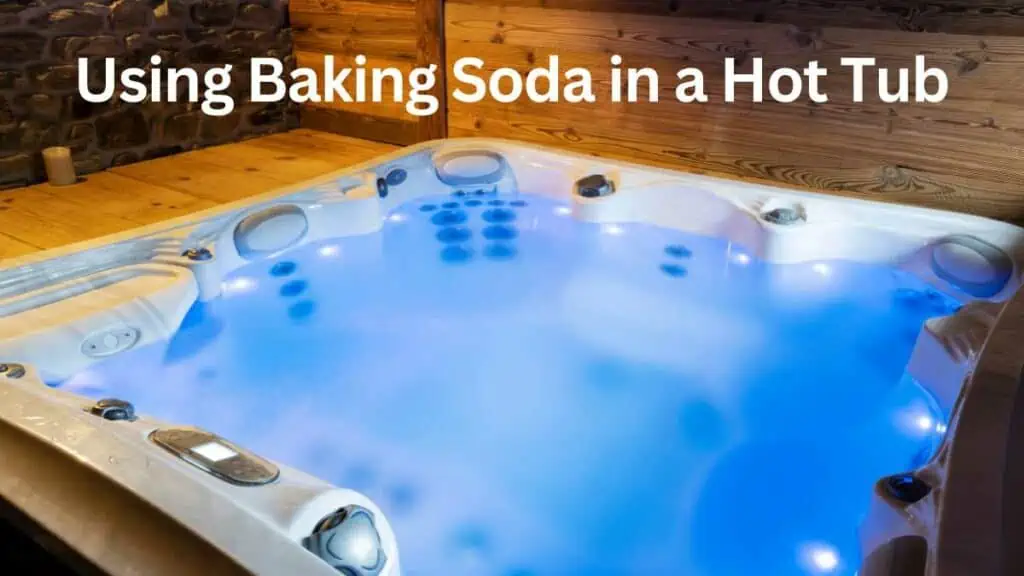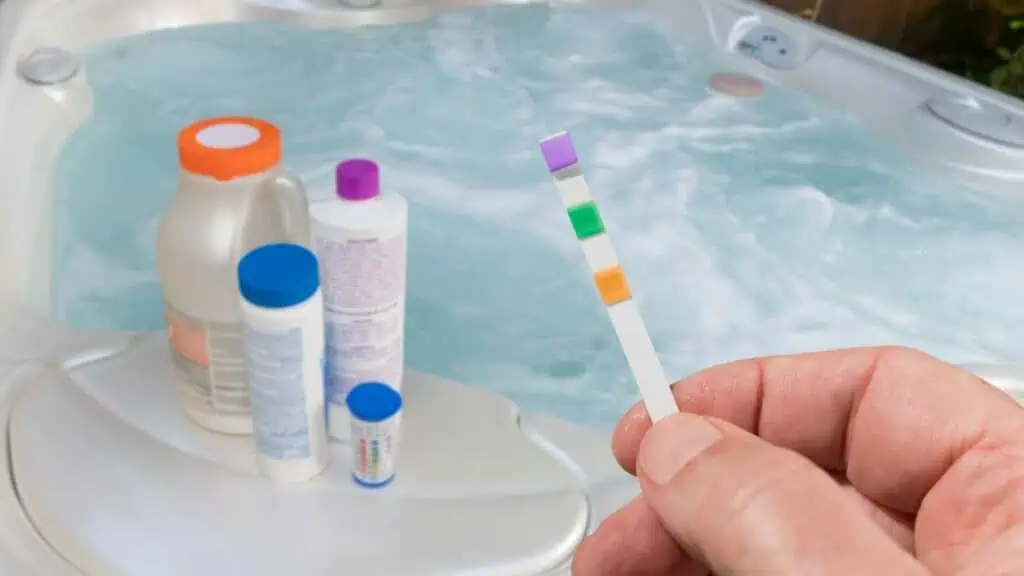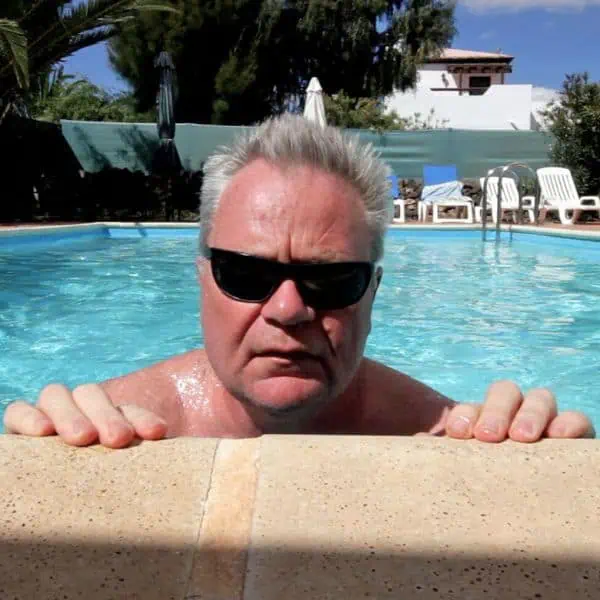Are you struggling to maintain your hot tub’s alkalinity level?
Adding baking soda is a common and effective solution, but figuring out the right amount can be tricky.
This post will show you how much baking soda you should add to your hot tub to raise the alkalinity levels. We’ll cover everything from calculating the correct amount based on your tub’s size to tips for testing and adjusting the levels over time.
So, if you’re ready to get your hot tub’s alkalinity levels back on track, here’s how much baking soda is needed to increase alkalinity.

Monitoring Alkalinity Levels in Hot Tubs
Using Test Strips
It is essential to routinely check the alkalinity levels in your hot tub to maintain a proper alkalinity and pH balance.
One of the easiest ways to do this is by using test strips. To test your hot tub water, dip a test strip into the water and follow the instructions on the test strip packaging.
Typically, you will need to wait a few seconds before comparing the color on the strip to the color chart on the container. This will help you determine your hot tub’s current total alkalinity and pH levels.
Recommended Test Strips
Using Baking Soda to Raise Alkalinity
Calculating Amount Needed
To determine how much baking soda (sodium bicarbonate) is needed to raise the alkalinity in your hot tub, you first need to test its current alkalinity level. For a balanced hot tub, the ideal total alkalinity level should be between 80 and 120 ppm (parts per million).
Once you have tested if you have a low total alkalinity level, use the calculator below to identify the correct amount of baking soda required to increase the alkalinity to the proper level.
Typically, you’ll need about 1.2 ounces of baking soda (roughly one tablespoon) to raise the alkalinity by 10 ppm for every 500 gallons of water in your hot tub. However, the exact amount may vary based on your tub’s size and specific needs.
Hot Tub Baking Soda Calculator
Enter the volume of your hot tub in gallons:
Enter the desired ppm increase:
How To Add Baking Soda in Hot Tub
- Measure the baking soda: Based on the calculated amount, measure the required quantity of baking soda and have it ready.
- Pre-dissolve the baking soda: Mix the baking soda with water in a bucket to create a slurry. This helps to dissolve the baking soda more efficiently in the hot tub water and prevents any undissolved particles from settling at the bottom.
- Pour the solution: Slowly pour the dissolved baking soda solution into the hot tub, ensuring you disperse it evenly.
- Let it circulate: Turn your hot tub’s circulation system back on. This allows the baking soda to mix well with the water.
- Retest alkalinity: After 24 hours of adding the baking soda, retest your hot tub’s alkalinity level. If it’s still below the ideal range, you may need to repeat these steps until it reaches the desired level.
By following these steps, you can confidently and effectively use baking soda to raise the alkalinity in your hot tub, ensuring a comfortable and safe soaking experience.
How to Raise pH without Raising Alkalinity in Hot Tub
Sometimes, using baking soda to raise the alkalinity in your hot tub might not be the best option.
Baking soda might not always be effective in raising the alkalinity levels for certain hot tubs, especially if the existing pH levels are extremely low but the total alkalinity is not low. You might need to use other products to raise the pH levels without significantly increasing the total alkalinity.
Sodium carbonate (soda ash) is another alkali that can raise the pH of your hot tub. But it raises the pH much quicker than baking soda without raising too much total alkalinity.
First, dissolve the appropriate amount of sodium carbonate in water before pouring it into the hot tub. Let the hot tub water circulate for at least 30 minutes before testing the water and adjusting the levels if necessary.
Baking Soda vs Alkalinity Increaser
Pool and hot tub stores (plus Amazon) sell alkalinity increasers or alkalinity ups. However, if you look at the label, you will see that it is just sodium bicarbonate, aka baking soda.
So it is often cheaper to just buy baking soda instead.
I should also point out that pH increaser or pH up, again sold in pool and hot tub stores, is normally just soda ash (sodium carbonate) so you can probably save some money buying that from a local store.
Hot Tub Maintenance Course
I bought Swim University’s Hot Tub Maintenance Course a while after I bought my first hot tub and struggled to maintain it. It was very well spent and has paid for itself many times over the years as I have saved by not needing to use as many chemicals as I did previously.
Listen to our Hot Tub Course Review Podcast:
When to Use Baking Soda or Soda Ash?
Whether to use baking soda (sodium bicarbonate/alkalinity increaser) or soda ash (sodium carbonate / pH increaser) can be confusing. However, this is it in a nutshell:
If you have a low alkalinity level and low pH, then use baking soda, as it raises the alkalinity and pH at a similar rate.
If your pH is low but alkalinity is in the desired range then use soda ash as it raises the pH quickly with minimal impact on the alkalinity levels.

Impact of Low Alkalinity Levels
Effects on Water Quality
When the total alkalinity level of your hot tub is low, it often leads to a low pH level, which means the water becomes more acidic. This imbalance can cause a variety of issues that affect water quality.
Acidic water can lead to metal parts and fixtures corrosion in your hot tub, resulting in costly damages. Furthermore, low alkalinity levels can cause:
- Cloudy water: Insufficient alkalinity impacts the water’s clarity, making it appear murky and uninviting.
- Skin and eye irritation: Acidic water can cause discomfort to your skin and eyes, making soaking in the hot tub unpleasant.
- Ineffective sanitizers: Low alkalinity levels can reduce the effectiveness of sanitizers like chlorine or bromine, allowing bacteria and algae to thrive.
Implications for Hot Tub Owners
As a hot tub owner, it’s crucial to maintain proper alkalinity levels to avoid the issues mentioned above. Here are a couple of reasons why monitoring and adjusting alkalinity levels is essential:
- Longevity of your hot tub: Low alkalinity can lead to corrosion and damage to your hot tub’s components, including heaters, pumps, and other metal parts. By maintaining the appropriate levels, you extend the life of your hot tub and its equipment.
- Comfort and enjoyment: Keeping the alkalinity levels in the recommended range ensures a comfortable and enjoyable experience for yourself and your guests. You can avoid skin and eye irritation caused by acidic water.
- Sanitation and safety: Proper alkalinity helps to maintain the effectiveness of sanitizers, ensuring that your hot tub remains clean and safe for use.
Monitoring and maintaining the alkalinity levels in your hot tub is essential to proper hot tub care.
By doing so, you can ensure the longevity of your hot tub, provide a comfortable experience, and maintain a clean, safe environment for you and your guests.
Understanding Alkalinity in Hot Tubs
The Role of Alkalinity
Alkalinity is crucial in maintaining the water balance in your hot tub. It serves as a buffer for your hot tub’s pH level, allowing it to resist sudden changes in the water chemistry. Having the right alkalinity levels ensures proper sanitization, prevents corrosion, and allows for better functioning of your hot tub equipment. The ideal range for total alkalinity in a hot tub is between 80 and 120 parts per million (ppm).
The pH-Acid-Alkalinity Relationship
Understanding the relationship between pH, acidity, and alkalinity is essential for maintaining your hot tub’s water chemistry. The pH scale ranges from 0 to 14, with 7 being neutral.
Values below 7 indicate acidic conditions, while those above 7 represent alkaline conditions. Alkalinity, on the other hand, measures water’s ability to neutralize acids.
When your hot tub’s alkalinity is within the recommended range, it helps stabilize its pH levels and prevents them from becoming too acidic or too alkaline.
An imbalance in the water’s alkalinity can lead to various issues, such as corroding equipment, discomforting bathers, and affecting the effectiveness of sanitization methods. Monitoring and maintaining the right balance is crucial for the optimal functioning of your hot tub.







Leave a Reply